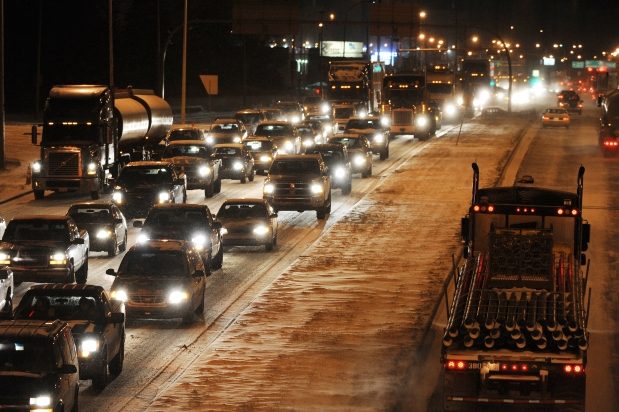EDMONTON – Edmontonians vent their traffic frustrations by giving their thumbs a Twitter workout, but our gripes have more to do with car crashes, transit and parking than with potholes, says an IBM study released Tuesday.

The company’s analysis of traffic commentary measured tens of thousands of traffic-related messages shared on social media in Edmonton, Vancouver, Toronto, Montreal and Halifax. The study zoomed in on the thousands of gripes, musings and wisecracks shared daily, mainly on Twitter, over an 11-month period ending in late November 2012.
“The smartphone is becoming a sensor about the people that are carrying them,” said Jean-Francois Barsoum, a senior consultant for IBM Smarter Cities, which conducted the study. “In fact, what people are hoping is that people will act on that. There’s almost an implied bargain, which is, ‘I’m going to share information about how I feel … but on the other hand, if I’m willing to share this, then I would like for it to be useful.’”
If you’re a follower of the @yegtraffic bot on twitter, you would be forgiven for thinking we’re a city of traffic complainers. In fact, Edmonton ranked second-lowest, behind Montreal, when it came to the number of traffic-themed thoughts shared on social media — about 1,200.
Of those, about 14 per cent had a positive outlook, roughly 28 per cent were negative and the remainder were considered neutral.
Crashes and the associated delays were the biggest trigger of our woes, Barsoum said. About 30 to 35 per cent of accident-related messages were negative, while about 18 per cent were positive, he added.
“As you would expect with many things, people don’t tweet as much when they’re happy about something. The same thing might apply with traffic.”
That might also apply to public transportation. Six per cent of transit-related tweets were positive, while about 22 per cent were negative, meaning we’re more likely to vent about a bus that’s tardy than laud one that’s on time.
Parking proved to be a polarizing subject, with Edmontonians split on whether we’re happy or annoyed with its availability. About 30 per cent of parking-themed sentiments were negative, while slightly less than 30 per cent were positive.
Harnessing those spur-of-the-moment thoughts shared on social media is the next frontier in data mining and could prove invaluable for city planners, Barsoum said.
“Historically, the way people have interacted with cities has been very structured: you go to a council meeting, you write a letter, you receive a response maybe a few months later,” Barsoum said. “But the way we’re growing up with social media now and interacting with social media now, we expect responses to be faster and in fact they can be because the information is shared in a way that’s much faster. But it’s probably not as easy to sift through because it’s unstructured.”
What about construction, and worse yet, those pesky potholes? Neither was a big source of our traffic chatter. Complaints about infrastructure — including potholes — may not feature as prominently in the data because the 2011-2012 winter was drier than most, meaning the city was able to get an early start on filling the craters.
But the city might want to pay attention to pothole gripes on social media, not just measuring how many times we complain, but figuring out which spots are the worst.
“People want to talk to the city and they want to use this new channel to do it, so cities are going to have to adapt the way they communicate with citizens, both listening and responding.” Barsoum said. “It’s just the way things are done now.”

Comments